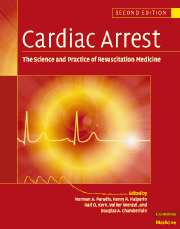Book contents
- Frontmatter
- Contents
- List of contributors
- Foreword
- Preface
- Part I Introduction
- Part II Basic science
- Part III The pathophysiology of global ischemia and reperfusion
- Part IV Therapy of sudden death
- Part V Postresuscitation disease and its care
- Part VI Special resuscitation circumstances
- 52 Prevention of sudden death in patients at risk: channelopathies and arrhythmic syndromes in the structurally normal heart
- 53 Pediatric cardiopulmonary resuscitation
- 54 Resuscitation in elder persons
- 55 Asphyxial cardiac arrest
- 56 Hemorrhagic shock and hypovolemic cardiac arrest
- 57 Cardiopulmonary resuscitation in hypothermic patients
- 58 Cardiac arrest due to poisoning
- 59 Cardiac arrest during anesthesia
- 60 Resuscitation of the pregnant patient suffering sudden cardiac death
- 61 Drowning
- 62 Anaphylactic shock
- 63 High altitude resuscitation
- 64 Electrical injuries
- 65 Rare syndromes, commotio cordis, sudden death in athletes
- Part VII Special issues in resuscitation
- Index
54 - Resuscitation in elder persons
from Part VI - Special resuscitation circumstances
Published online by Cambridge University Press: 06 January 2010
- Frontmatter
- Contents
- List of contributors
- Foreword
- Preface
- Part I Introduction
- Part II Basic science
- Part III The pathophysiology of global ischemia and reperfusion
- Part IV Therapy of sudden death
- Part V Postresuscitation disease and its care
- Part VI Special resuscitation circumstances
- 52 Prevention of sudden death in patients at risk: channelopathies and arrhythmic syndromes in the structurally normal heart
- 53 Pediatric cardiopulmonary resuscitation
- 54 Resuscitation in elder persons
- 55 Asphyxial cardiac arrest
- 56 Hemorrhagic shock and hypovolemic cardiac arrest
- 57 Cardiopulmonary resuscitation in hypothermic patients
- 58 Cardiac arrest due to poisoning
- 59 Cardiac arrest during anesthesia
- 60 Resuscitation of the pregnant patient suffering sudden cardiac death
- 61 Drowning
- 62 Anaphylactic shock
- 63 High altitude resuscitation
- 64 Electrical injuries
- 65 Rare syndromes, commotio cordis, sudden death in athletes
- Part VII Special issues in resuscitation
- Index
Summary
The percentage of elder persons throughout the developed world is rapidly increasing. In the USA, for example, the percentage of the population 65 years and older has increased from 4% in 1900 to 13% in 1990 and is projected to be 22% by 2030. The fastest growing segment of the elderly population is the oldest persons who are 85 years or older and made up about 1% of the population in 1990 but will increase to more than 5% over the next 30 years.
Similarly in developed countries worldwide (including Japan, Australia, New Zealand, and countries in Europe and North America) the elderly segment of the population is increasing significantly. The highest proportion of elderly people in the world is in Sweden, with 18% of the population 65 years or older. This demographic change with increasing numbers of elder persons in the population is expected to continue over the next 30 to 50 years. By the year 2025, 5%–9% of the population in the developed nations will be 80 years or older.
This graying of the population in the developed world is largely due to several demographic factors. This includes a decline in the mortality rate especially from cardiovascular diseases and decreased fertility rates in much of the developed world. The post-World War II baby boom generation in the USA consists of 75 million persons born between 1946 and 1964. These people will be entering the geriatric population over the next 20 years.
This increased population of elder persons will have a major impact on the delivery of healthcare.
- Type
- Chapter
- Information
- Cardiac ArrestThe Science and Practice of Resuscitation Medicine, pp. 960 - 968Publisher: Cambridge University PressPrint publication year: 2007



